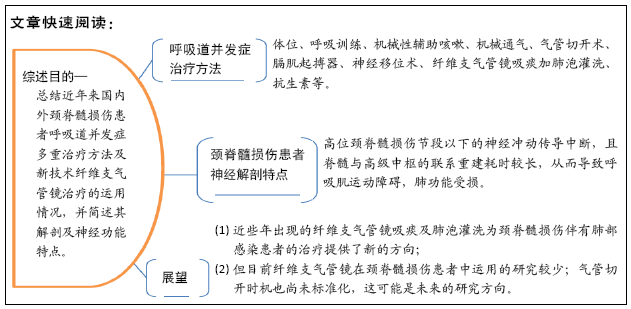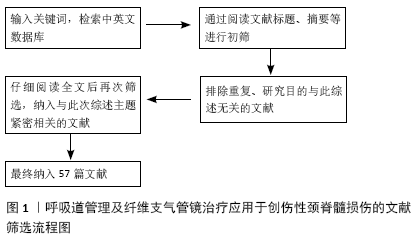[1] 冯世庆. 脊髓损伤神经修复时间窗的相关问题[J] . 中华创伤杂志, 2019,35(8):673-676.
[2] CHEN J, CHEN Z, ZHANG K, et al. Epidemiological features of traumatic spinal cord injury in Guangdong Province. China J Spinal Cord Med. 2020:1-6.
[3] 高朝娜,郭锦丽,程向丽,等.急性颈脊髓损伤患者的呼吸管理研究现状[J]. 中国脊柱脊髓杂志,2018,28(7):658-662.
[4] STOTHERS L, MACNAB AJ, MUKISA R, et al. Traumatic spinal cord injury in Uganda: a prevention strategy and mechanism to improve home care. Int J Epidemiol. 2017;46:1086-1090.
[5] RAMAMURTHY P, KUMAR N, OSMAN A. Epidemiology, neurological and functional outcome of concomitant traumatic brain and spinal cord injury: An Oswestry experience. Trauma. 2017;19(1 suppl):30-32.
[6] KRIZ J, KULAKOVSKA M, DAVIDOVA H, et al. Incidence of acute spinal cord injury in the Czech Republic: a prospective epidemiological study 2006-2015. Spinal Cord. 2017;55(9):870-874.
[7] 徐艳松,罗大卿,潘文辉,等.创伤性颈脊髓损伤的流行病学分析[J].中华急诊医学杂志,2019,28(1):84-89.
[8] 李景伟,冯世庆,焦新旭,等. 急性脊髓损伤患者早期并发症及危险因素分析[J].中国脊柱脊髓杂志,2011,21(7):569-572.
[9] DITUNNO JF,LITTLE JW,TESSLER A, et al. Spinal shock revisited: a four-phase model. Spinal Cord. 2004;42:383-395.
[10] 孔琴,丁小萍,戴晓洁,等.咳嗽训练在颈脊髓损伤伴不全瘫患者排痰中的应用[J].上海护理,2018,18(5):40-43.
[11] 戴力扬.急性脊髓损伤后呼吸系统并发症[J].中国危重病急救医学, 2000,12(2):118-120.
[12] BERLLY M, SHEM K. Respiratory management during the first five days after spinal cord injury. J Spinal Cord Med. 2007;30:309-318.
[13] SONG J, SHAO J, QI HH, et al. Risk factors for respiratory failure with tetraplegia after acute traumatic cervical spinal cord injury. Eur Rev Med Pharmacol Sci. 2015;19:9-14.
[14] HASSID VJ, SCHINCO MA, TEPAS JJ, et al. Definitive establishment of airway control is critical for optimal outcome in lower cervical spinal cord injury. J Trauma. 2008;65:1328-1332.
[15] LIEBSCHER T, NIEDEGGEN A, ESTEL B, et al. Airway complications in traumatic lower cervical spinal cord injury: A retrospective study. J Spinal Cord Med. 2015;38:607-614.
[16] WONG SL, SHEM K, CREW J. Specialized respiratory management for acute cervical spinal cord injury:a retrospective analysis. Top Spinal Cord Inj Rehabil. 2012;18:283-290.
[17] BERLOWITZ DJ, WADSWORTH B, ROSS J. Respiratory problems and management in people with spinal cord injury. Breathe. 2016;12(4): 328-340.
[18] CAMERON GS, SCOTT JW, JOUSSE AT, et al. Diaphragmatic respiration in the quadriplegic patient and the effect of position on his vital capacity. Ann Surg. 1955;141:451-456.
[19] Wadsworth BM, Haines TP, Cornwell PL, et al. Abdominal binder use in people with spinal cord injuries: a systematic review and meta-analysis. Spinal Cord. 2009;47(4):274-285.
[20] NYGREN-BONNIER M, SCHIFFER TA, LINDHOLM P. Acute effects of glossopharyngeal insufflation in people with cervical spinal cord injury. J Spinal Cord Med. 2018;41:85-90.
[21] 孙亭菲,张俐,吴静,等.主动呼吸循环技术对颈脊髓损伤患者肺功能的影响[J].当代护士(中旬刊),2016,23(9):36-37.
[22] Berlowitz DJ, Tamplin J. Respiratory muscle training for cervical spinal cord injury. Cochrane Database Syst Rev. 2013;(7):CD008507.
[23] TAMPLIN J, BERLOWITZ DJ. A systematic review and meta-analysis of the effects of respiratory muscle training on pulmonary function in tetraplegia. Spinal Cord. 2014;52:175-180.
[24] MCDONALD T, STILLER K. Inspiratory muscle training is feasible and safe for patients with acute spinal cord injury. J Spinal Cord Med. 2018;(1):1-8.
[25] 史洁.颈脊髓损伤气管切开术后病人的呼吸道管理[J].护理研究, 2017,31(19):2407-2409.
[26] 岳伟岗,张志刚,马芳丽,等.咳嗽辅助仪用于清理神经肌肉疾病合并呼吸功能不全患者气道分泌物的临床疗效[J]. 中国呼吸与危重监护杂志,2014,13(6):588-590.
[27] CHATWIN M, ROSS E, HART N, et al. Cough augmentation with mechanical insufflation/exsufflation in patients with neuromuscular weakness. Eur Respir J. 2003;21:502-508.
[28] KORNBLITH LZ, KUTCHER ME, CALLCUT RA, et al. Mechanical ventilation weaning and estuation after spinal cord injury: a western trauma association multicenter study. J Trauma Acute Care Surg. 2013; 75(6):1060-1070.
[29] KIM DH, KANG SW, CHOI WA, et al. Successful tracheostomy decannulation after complete or sensory incomplete cervical spinal cord injury. Spinal Cord. 2017;55:601-605.
[30] 史洁.颈脊髓损伤气管切开术后病人的呼吸道管理[J].护理研究, 2017,31(19):2407-2409.
[31] FLANAGAN CD, CHILDS BR, MOORE TA, et al. Early Tracheostomy in Patients With Traumatic Cervical Spinal Cord Injury Appears Safe and May Improve Outcomes. Spine. 2018;43:1110-1116.
[32] 陈佳楠,赵刘军.急诊经皮气管切开在颈脊髓损伤治疗中的应用价值[J].现代实用医学,2019,31(1):93-95.
[33] BRASS P, HELLMICH M, LADRA A, et al. Percutaneous techniques versus surgical techniques for tracheostomy. Cochrane Database Syst Rev. 2016;7:CD008045.
[34] WANG Y, GUO Z, FAN D, et al. A meta-analysis of the influencing factors for tracheostomy after cervical spinal cord injury. Biomed Res Int. 2018;2018:5895830.
[35] 李强,朱曦,么改琦.急性颈脊髓损伤患者气管切开时机的临床研究[J].中国微创外科杂志,2017,17(2):159-162.
[36] YANG XX, HUANG ZQ, LI ZH, et al. Risk factors and the surgery affection of respiratory complication and its mortality after acute traumatic cervical spinal cord injury. Medicine (Baltimore). 2017;96:e7887.
[37] SONG J, SHAO J, QI HH, et al. Risk factors for respiratory failure with tetraplegia after acute traumatic cervical spinal cord injury. Eur Rev Med Pharmacol Sci. 2015;19:9-14.
[38] Bourassa-Moreau É, Mac-Thiong JM, Ehrmann Feldman D, et al. Complications in acute phase hospitalization of traumatic spinal cord injury: does surgical timing matter? J Trauma Acute Care Surg. 2013;74:849-854.
[39] JACKSON AB, GROOMES TE. Incidence of respiratory complications following spinal cord injury. Arch Phys Med Rehabil. 1994;75:270-275.
[40] POSLUSZNY JA JR, ONDERS R, KERWIN AJ, et al. Multicenter review of diaphragm pacing in spinal cord injury: successful not only in weaning from ventilators but also in bridging to independent respiration. J Trauma Acute Care Surg. 2014;76(2):303-310.
[41] WINSLOW C, BODE RK, FELTON D, et al. Impact of respiratory complications on length of stay and hospital costs in acute cervical spine injury. Chest. 2002;121:1548-1554.
[42] 杨明亮,赵红梅,李建军,等.植入式膈肌起搏器在高位颈髓损伤患者中的应用经验及文献分析[J] .中华结核和呼吸杂志,2018, 41(9):718-723.
[43] 张成林,周许辉,贾连顺,等.神经移位技术在高位颈脊髓损伤后膈肌功能重建中的应用[J].中国矫形外科杂志,2015,23(8):718-722.
[44] 范永会,王星利,卢高方.纤维支气管镜联合肺泡灌洗治疗重症肺部感染的价值分析[J].临床研究,2019,27(6):110-112.
[45] 隗世波,刘青云,钟群琼.纤维支气管镜联合氨溴索肺泡灌洗治疗重症肺炎伴肺不张的效果及对血清PCT和hs-CRP的影响[J].解放军医药杂志,2019,31(9):26-30.
[46] 朱蓉,洪永青,孟自力,等.机械通气联合支气管肺泡灌洗治疗COPD合并呼吸衰竭随机对照研究[J].实用医学杂志,2014,30(18): 2919-2921.
[47] ZHAO H, GU H, LIU T, et al. Analysis of curative effect of adjuvant therapy with bronchoalveolar lavage on COPD patients complicated with pneumonia. Exp Ther Med. 2018;16:3799-3804.
[48] KIM EJ, JUNG CY, KIM KC. Effectiveness and Safety of High-Flow Nasal Cannula Oxygen Delivery during Bronchoalveolar Lavage in Acute Respiratory Failure Patients. Tuberc Respir Dis (Seoul). 2018;81:319-329.
[49] 龙何英,吴雪坚,黄珊.纤维支气管镜灌洗治疗老年坠积性肺炎的临床观察研究[J].当代护士(上旬刊),2019,26(4):46-47.
[50] 昌宏,潘剑成,张宗明,等.支气管镜吸痰灌洗治疗颈脊髓损伤并发呼吸道梗阻[J].实用骨科杂志,2009,15(12):917-919.
[51] 刘峰.分析重症肺部感染患者进行纤维支气管镜吸痰治疗对其呼吸功能和炎性应激反应的影响[J].世界最新医学信息文摘,2019, 19(44):5-6.
[52] 潘剑成,昌宏,林鸿,等. 颈椎骨折脊髓损伤术后并发呼吸道梗阻使用纤维支气管镜吸痰灌洗的疗效观察[J]. 重庆医学,2009,38(1): 73-74.
[53] ULL C, AACH M, REICHERT J, et al. Successful non-surgical management of pleuroparenchymal fistula following cervical intraspinal empyema. Monaldi Arch Chest Dis. 2018;88(1):889.
[54] 段满生,舒勇,曹凯,等.650例急性脊髓损伤早期并发症及其相关因素的临床分析[J]中华物理医学与康复杂志,2009,31(9):632-634.
[55] 古正涛,邓小玲,郑国栋,等.颈脊髓损伤患者医院获得性肺炎及其病原菌分析[J]. 中国脊柱脊髓杂志,2011,21(1):33-37.
[56] 赵国伟,高钧.颈脊髓损伤患者肺部感染的病原菌特点及抗生素应用[J].中国康复理论与实践,2016,22(7):844-847.
[57] 李文选,吴一民,索英,等.急性颈脊髓损伤患者肺部感染的危险因素及病原菌分析[J].中国脊柱脊髓杂志,2015,25(7):648-652.
|


